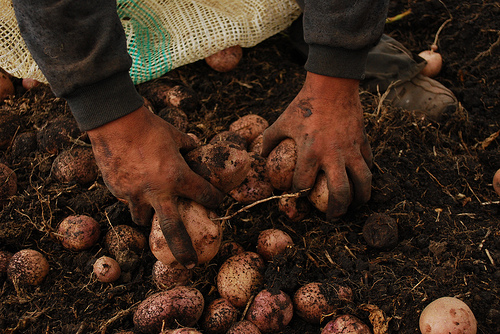Saliva from moth larva increases potato crop yields in Colombia
Many farmers throughout Latin America and around the world rely on pesticides to control pest invasions; this method is not only costly but has been shown to cause adverse health effects as well. Due to the risks involved in pesticide usage, and the ever-increasing demand for high-yield crops, new methods of controlling pest invasions are being explored by researchers regularly. And as counterintuitive as these new findings sound, ecological scientists have discovered that, in the case of Colombian potato farms in the Andes, the pests themselves could actually increase productivity.
According to a recent study in Ecological Applications (pre-print), one of the most important potato pests in Latin America—the Guatemalan potato moth (Tecia solanivora) larva—dramatically increased potato yields in Colombia. The cause of larger, more abundant potatoes, said Katja Poveda from Georg August University in Germany and colleagues, lies in these pests’ saliva.
Specifically, when moth larva infested one of the tubers (potatoes are stem tubers) of a Colombian Andes potato plant (Solanum tuberosum), the rest of the plant, including the remaining tubers, increased in size and abundance. The resulting yield (when infested potatoes were removed) weighed 2.5 times more than the yield from completely undamaged plants.
This dramatic increase remained constant when up to 20 percent of the potatoes were damaged—in other words, the healthy, marketable potatoes were larger and more abundant in a plant with 20 percent of its potatoes infested with larva than the yield from a completely undamaged plant. And even when 50 percent of the potatoes were damaged, the plant produced yields equal to those of completely undamaged plants.
It turns out, as the researchers discovered, that saliva produced in the foregut of the Guatemalan potato moth larva contains chemical elicitors which are distributed system-wide in the plant. As the larva regurgitate digested tuber, they release compounds found in the gut that elicits a growth response in the plant. The plant then “overcompensates” for the damage by producing more, and larger, tubers, said the authors.
While the researchers did not locate the chemical responsible for the plant’s overcompensation, they described the potential applications in agriculture:
The identification of the underlying molecular and metabolic mechanisms, and the isolation and application of the herbivore-derived elicitors, could provide promising tools for managing the impact of herbivores on crops.
Poveda, K., Gomez Jimenez, M., & Kessler, A. (2010). The enemy as ally: herbivore-induced increase in crop yield Ecological Applications DOI: 10.1890/09-1726
Credit: Troskiller
